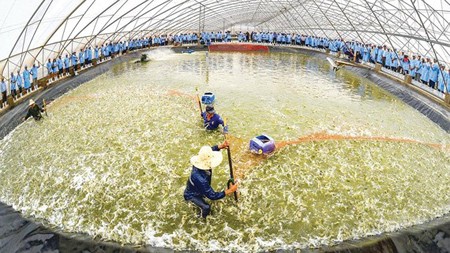
In 2018, the total output value of agriculture in Vietnam increased by 3.86 percent compared to 2017, and the export turnover reached $40.02 billion, a rise of 9.6 percent compared to the previous year. The top 10 kinds of produce earned more than $17 billion from export.
Analysis show that science-technology contributed a great deal to those impressive results, thanks to the encouraging policies to boost large-scale manufacturing, cooperate agricultural units in value chains, apply hi-tech equipment, introduce organic agriculture concepts, and improve the market forecast ability in order to timely direct manufacturing and consuming activities in the market, with more focus of beneficial produce.
According to Deputy Minister of Science and Technology Pham Cong Tac, thanks to the implementation of science-technology, the agriculture sector was able to noticeably minimize produce loss, such as rice to just under 10 percent. In addition, mechanization in ploughing fields reached around 94 percent, a growth of 1 percent compared to 2017; in sowing and harvesting rice 42 percent; in spraying plant protection chemicals 77 percent. The number of machines and tools used in agriculture developed by 2 percent compared to the previous year.
Certain giant enterprises have paid more attention to produce manufacturing to increase quality, diversify packaging and types of goods. In 2018, 16 new factories to process vegetables, pork, and poultry were established, with the total investment amount of VND8,700 billion (approx. $375 million). This participation of large-scale corporations, along with the growth of specialized saplings for export, is a precious chance for Vietnamese agriculture to renovate itself.
For instance, the northern province of Bac Giang now has 71 models that apply hi-tech agriculture, with 163 piloting fields specializing in fruit trees on a surface area of 48,300 hectares. They are earning added value and increasing the competitiveness of the regional agriculture. 8 staple kinds of produce in Bac Giang Province have been recognized so far, creating a huge amount of added value.
Take the 29,000-hectare area of lychee in the province as an example. It earned VND5,300 billion ($228,4 million) and VND5,800 billion ($250 million) in 2017 and 2018 respectively. After applying new agricultural technologies, the lychee surface area which met the VietGAP standards rose from 1,000 hectares to 13,500 hectares, whereas the area for the Global GAP reached 218.5 hectares. The US issued IRADS codes for 394 households to grow and process lychee for exportation.
Bac Giang Province also implemented high technologies in produce preservation like CAS from Japan, Jural from Israel, or MAP films, which all increase the preservation time of fruits and maintain their quality. Thanks to them, Bac Giang lychee is now exported to more than 30 nations worldwide, and gains geographical indication rights in the 9 countries of China, the Republic of Korea, Japan, Laos, Cambodia, the US, Australia, Singapore, and Malaysia.
The Minister of Agriculture and Rural Development Nguyen Xuan Cuong praised the contribution of science-technology in agriculture growth, hoping that in the near future, there will be a perfect institution for science-technology, especially for developing specialized agricultural standards, so that Vietnamese produce is able to compete with the foreign counterparts. He also suggested that the Ministry of Science and Technology should pay more attention to startup ecosystems in agriculture.
























